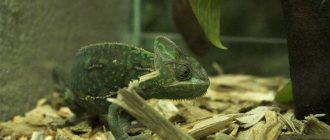Author: Lentochka
25 April 2022 09:47
Tags: interesting facts chameleons
9792
21
Without a doubt, chameleons are one of the most interesting representatives of the animal world. Everyone knows that chameleons can change the color of their skin, but what else do you know about these amazingly cute animals? Our selection of interesting facts will help you fill gaps in knowledge.
0
See all photos in the gallery
Although chameleons can be found in many parts of the world with warm climates, almost half of the two hundred known species are found in Madagascar.
0
Most chameleons lay eggs, but some give birth to babies in soft, translucent shells that resemble a cocoon.
×
0
The word "chameleon" comes from the Greek "chamaeleón", which literally means "ground lion".
The chameleon's tongue shoots out at extraordinary speed, reaching its prey in 0.07 seconds.
0
Unfortunately, the ability to mimicry does not save chameleons from deforestation, which is their main habitat. Currently, about 9 species are on the verge of extinction, and another 37 species are threatened.
0
How a chameleon uses its tongue
The animal moves slowly. Therefore, the success of his hunt depends on the accuracy and speed of his weapon - a long tongue. Depending on the type and size of the chameleon, it helps to cope not only with insects, but also with larger prey - snakes and rodents . Sometimes a representative of the jungle is not averse to eating the fruits and foliage of plants.
Hunting
In reality it looks like this.
- Binocular vision allows the reptile to control its environment within a 360-degree radius around itself. Having tracked prey, the lizard carefully evaluates the distance to it, focusing both eyes on the object.
- The animal takes a convenient position for attack, positioned at a distance equal to the length of its body.
- The muscles of the larynx are brought into a state of readiness. A sign of this is the tip of the tongue sticking out slightly from the mouth.
- This is followed by a sharp ejection of the organ and its engulfment of the prey . At the moment of impact on the target, the tip is flattened, covering the target with tiny growths.
Reference! After the “shot”, the chameleon cannot influence the trajectory of movement. If you aim poorly, you may miss.
- Closing its eyes so as not to damage them, the lizard returns the organ to its mouth along with the catch. If an item is not suitable for eating, it is easily pushed out.
- After this, the muscles in the mouth relax. Teeth and jaws help kill prey. Without chewing, the hunter swallows the prey whole.
Important! Evolution followed the path of honing shooting accuracy. The process is energy-consuming: having failed to catch prey, the chameleon has to accumulate strength for a long time for the next attempt.
A tongue with such unique properties is unique to chameleons and is unknown among other representatives of the fauna. For hundreds of years, the principle of its operation remained a mystery to scientists.
When frightened they increase in size
Sometimes, under the influence of mood, the color of a chameleon can change greatly. For example, if an animal feels threatened, it can change color from green to the darkest. But that is not all. At such moments, the chameleon can swell and at the same time greatly increase in size .
At the same time, it expands its mouth wide and makes sounds similar to the hissing of a snake. These animals can be quite formidable during mating games. Almost the same action occurs.
Description and characteristics of the chameleon
The chameleon is a lizard adapted to move through trees and plants; it belongs to the reptiles of the chameleon family.
You might be interested to know how chameleons change color.
Outwardly, it is a classic lizard, usually large in size (body length reaches 30 cm), but there are also small varieties that grow only 3-5 cm in length. The lizard's body is slightly flattened, and a ridge of scaly skin growths runs along its back.
The head is shaped like a helmet due to bone growths. The paws are long, the toes are fused into 2 groups so that the shape resembles a claw. The animal's tail is long and flexible, thick at the base, tapering at the end. The eyes are set on the sides of the head, covered with a dense eyelid.
Did you know? The vision of chameleons is very unusual: the eyes focus independently of each other, which allows the animal to see different objects at the same time.
Chameleons live in warm regions: India, the Middle East, Africa, Madagascar. The jungle is their favorite place to live.
Animals feed mainly on insects; larger species can hunt snakes or rodents, but they do not disdain plant foods: fruits and greens of some plants.
We recommend that you familiarize yourself with the following types of chameleons: panther, Yemen, Jackson's chameleon.
The perfect silent killer - chameleon
Scientists have only now been able to explain how these animals capture prey
Do you see a talented hunter in this photo?
No? And he is. Chameleons are amazing creatures. Their vision, skin structure, hunting principle - all this is unique. The chameleon looks a little strange, even funny. But this is for a person. And in nature, a chameleon is a dangerous killer, quiet and precise. True, the chameleon hunts only relatively small insects, which it can swallow. As soon as the chameleon sees prey, it throws out a long tongue that is very sticky at the end (we’ll talk about the reason for this stickiness below). A chameleon's tongue is one of the most developed organs of the body. We can say that this is his sixth limb (if you count his prehensile tail as his fifth). Using its tongue, a chameleon is able to capture and swallow prey up to a third of the animal's weight. And all this without the slightest movement of the body, only the tongue works.
How exactly a chameleon captures its prey has remained a mystery for many years. It was difficult to understand even how the animal throws out its tongue at such speed over such distances (two body lengths in a fraction of a second). And how the victim is captured and returned to the chameleon’s mouth is an even more complex question. As it turns out, the reason for the success of the silent hunt is the stickiness of the chameleon’s tongue. It's not just sticky, but extremely sticky. This property of the tongue is due to the viscosity of the chameleon's saliva. It is 400 times more viscous than human saliva. Under certain conditions, this substance behaves like an elastic solid rather than a liquid. This is the key to understanding the mechanism of “language capture”.
Saliva is produced in very small quantities by special glands of the tongue. Scientists managed to measure the viscosity of this liquid, despite all the difficulties. Using bait, the chameleon was able to force its tongue out, hitting a microscope slide. There was saliva imprinted on the glass. After this, the second phase of the experiment immediately began - measuring viscosity. The scientists used a second glass coated with a control liquid whose viscosity was known. After that, tiny metal balls began to roll down the first and second liquids. The glass was tilted at a certain angle. The maximum angle of inclination at which the ball did not roll down, but remained in the test liquid, made it possible to measure the viscosity of this liquid.
"The unexpectedly high viscosity of the saliva suggests that prey stick to the chameleon's tongue through viscous adhesion," said study leader Pascal Damman. “But even knowing this value is not enough to determine the strength of viscous adhesion. We used a dynamic retraction phase model to measure adhesion force.”
Scientists were able to find out that when the tongue hits an insect, the tongue expands and the area of contact with the victim increases. This means that the adhesion of the insect to the surface of the tongue increases significantly. Despite the fact that the tongue quickly returns, the grip force is enough to prevent the victim from “falling off.” “Viscous adhesion is an effective way to hold even very large prey,” says the scientist. The viscous fluid is produced only when the tongue is thrown out.
Measuring the viscosity of chameleon saliva confirmed one of the assumptions about how the chameleon holds prey on the tip of its tongue. Back in the 50s of the last century, the “sticking theory” was created, according to which the victim simply sticks to a certain sticky substance on the tip of the chameleon’s tongue. After this, the assumption was discarded as untenable, considering that since a chameleon can throw an inedible object out of its mouth, it means that saliva has nothing to do with it. Confirmation also came from scientists who conducted an experiment with blocking the animal’s nerves responsible for the functioning of the tongue. After blocking the nerve channels that control the tip of the tongue, chameleons were unable to capture victims. Yes, the tongue was thrown out, but the prey did not stick to it.
Now it turns out that the scientists who wrote about the chameleon in the 50s were right. Another interesting point. Chameleons can release large victims without any problems (if the prey is very strong) due to the fact that when thrown out, the tongue takes a certain shape, similar to a bowl. It was called the "suction cup". Small insects immediately end up in the “bowl” when captured. But large prey is only partially covered by the tongue.
The tongue is thrown out by the action of two muscles on either side of the chameleon's hyoid bone. It comes back in the form of a spiral scroll.
How fast is a chameleon?
This year, biologists from the American Brown University decided to determine how fast chameleons are as hunters. They selected 20 species of chameleons and began filming the capture of prey by a representative of each species with a high-speed camera (up to 3000 frames per second). As it turned out, on average, the process of throwing out the tongue takes only 1/20 of a second. Returning the tongue to its original position with the victim takes about half a second. In three seconds, a chameleon can identify and catch up to 4 insects. When the chameleon is not hunting, the tongue is held in place by a special bone in the lower jaw.
As for the hunting efficiency of various species, the most deadly hunters were chameleons of the species Rhampholeon spinosus. Their body size is only 4 centimeters, but their tongue is projected to a length 2.5 times the length of the animal’s body. At the same time, the tongue picks up a speed of 100 km/h in just a hundredth of a second.
Slightly less efficient hunters are Brookesia superciliaris, Rieppeleon brevicaudatus and Trioceros hoehnelii. Their tongue is twice as long as their body. And the least lethal for the victim is the giant chameleon Furcifer oustaleti, which grows to a size of 60 centimeters or more.
According to experts, the accuracy of the tongue throw of small chameleon species is explained by high energy costs. If the little chameleon misses, he will have to gain strength for the next attack. But a large chameleon has enough energy to throw again.
What else can a chameleon do?
Of course, change the coloring and body pattern. This makes the animal even more deadly to its victims. The ability to change color is associated with the structure of the chameleon's skin. The outer layer of the skin contains a large number of chromatophore cells. These cells contain grains of pigments of various colors, including black, dark brown, reddish and yellow. The combination of these colors allows the chameleon to color its skin in many different shades.
In addition to chromatophores, chameleons also have special cells with crystals inside that can reflect and refract light. And in the deepest subcutaneous layer of the chameleon, scientists discovered crystals that help the animal reflect infrared radiation. Thanks to these cells, the chameleon can reflect infrared radiation, maintaining body temperature in hot weather.
The animal can quickly change body color from black to whitish. In this case, the color of not all the skin, but some part of it, may change.
Color changes under the influence of various factors, including the external environment and the state of the animal’s body. Some species of chameleons change skin color not to hide, but to communicate with members of their own species.











